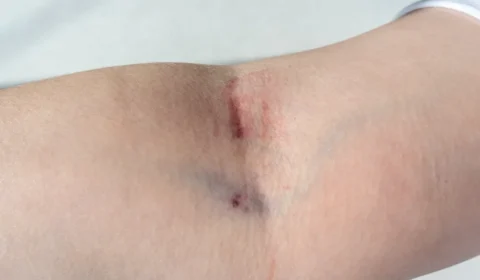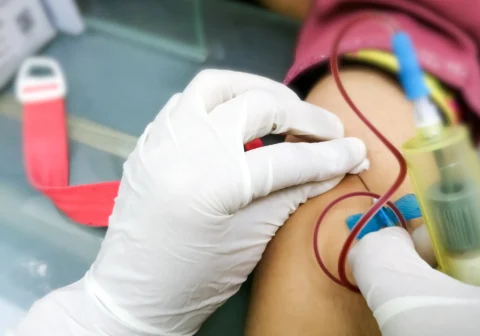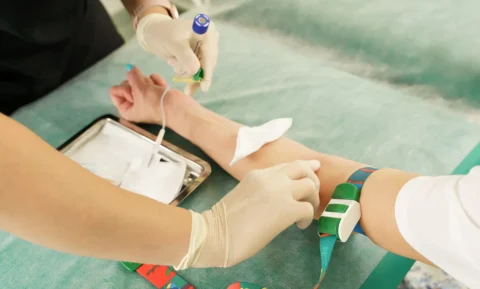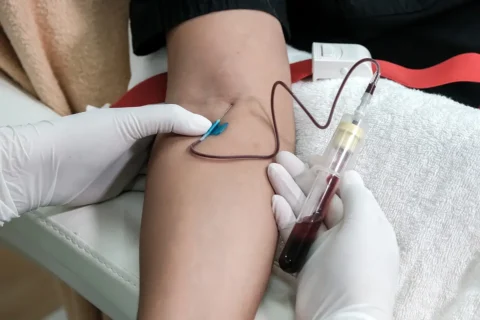In the cosmetics industry, injectable procedures are some of the most recognizable procedures. It doesn’t help that patients frequently have a fear of needles, which you’ll need to alleviate in order to treat them effectively. The necessity of receiving proper training on how to perform injectable cosmetic procedures can’t be overstated. It’s not quite that simple, as there are many alternative training possibilities that are competing for recognition.
So what’s better for Botox and filler training: blended or online classes? Not all online courses in dermal fillers and Botox injections go in-depth on step-by-step procedure or technique, in contrast to blended learning training. Some completely highlight fundamental subjects like facial anatomy or on non-medical subjects like marketing or the management of aesthetics practices. Training both online and hands-on is an important aspect of blended learning.
Off-Label Botox and Filler Training: Blended vs Online Classes
Working in the cosmetics sector can be difficult because of the amount of care that is expected of you and the faith that your patients will place in you. In the cosmetics industry, you’ll be trusted by your patients and are expected to provide them with high-quality care, which can be challenging.
There are constantly new uses for injectable products being approved, and new injectable products are being approved on a regular basis. This is why it’s crucial to select a course that explains how to employ the most recent FDA-approved and off-label treatments for both cosmetic and medical reasons.
There are several botulinum toxin injection and dermal filler training programs available, however make sure to enroll in a program that will give you more credibility. The best course of action is to choose one that fits your schedule and aligns with your career goals.
Blended Learning for Injectable Treatments
Blended learning for injectable treatment training might be the ideal choice for you if your schedule is very hectic. There are several training programs that permit part-time study; some will give you the choice to combine traditional hands-on classroom-based modules with independently studying online course materials.
On the majority of blended programs, web conferencing technology and collaborative online infrastructures will allow you to communicate with your peers and instructors. You can access a variety of programs that give you access to interactive digital resources and notes, audio and video courses, as well as online communities and learning settings.
In order to imitate real-life situations, patient-model training is carried out using real people and actual products under the close supervision of a trainer. It has a range of advantages, including the opportunity to more accurately hone your ability to identify the proper anatomy to direct you to the precise injection sites. When the day comes that you’re injecting on your own, your technique will already be excellent because you’re practicing your own clinical skills.
Patient-Model Training: The Importance of Hands-on Practice
A student can get a sense of what to expect during a real in-office consultation with a real patient by receiving hands-on instruction with real patient models and actual equipment. Almost all of the processes that occur in an aesthetic clinical environment can be simulated in an injectables training for nurses and physicians with this feature.
Hands-on training enables injectors the chance to put all of the theoretical knowledge they have acquired from reading books and the many online resources into practice on a real model and to personally experience what they have observed during live demonstrations. Students will be able to observe the typical facial injection sites, such as the brow, eyelids, and nasolabial folds.
More significantly, students will be able to observe firsthand the effects of the treatment on patients and their reactions. They won’t be as surprised by their first actual injectables training, because of this experience. In this way, they will be able to offer their clients proper advice regarding recovery and aftercare.
In the same way that each individual is unique, every face and every injectable procedure will be as well. The trainee becomes acutely aware of this aspect even in the early stages of learning due to practical patient model instruction. This effectively develops the critical thinking abilities of trainees as well as how to construct an ideal treatment plan that will use cutting-edge injectable procedures to satisfy each client’s unique aesthetic or medical objectives.
Online Classes for Injectable Treatments
The field of medical aesthetics is continuously evolving. However, time-constrained medical professionals frequently lack the means to travel for continuing education or even take a full day off from work to attend a local conference. This issue can be resolved by taking an extensive online aesthetics course.
A virtual substitute for on-site teaching in aesthetic medicine is an online course for aesthetics training. The objective is to help participants advance or broaden their professions by teaching or reinforcing aesthetic medicine techniques.
Participants in continuing medical education programs are often restricted to licensed practitioners. The majority of self-paced, totally virtual online aesthetic courses. These courses combine exams, extra readings and notes, and instructional videos to provide the information.
Participants may need as little as a few hours to as much as a dozen hours to finish all the required courses, depending on the scope of the course. Students who pass the exam at the end of each course are given certificates of completion.
Why Training in Injectable Treatments Is Crucial
The ability to manage complications is an important factor in choosing to receive certification as a medical expert to perform procedures like dermal filler treatments. In addition to confidently performing a variety of facial aesthetic procedures, properly trained medical practitioners are also equipped to handle any potential complications, like muscle weakness.
Despite the widespread consensus that only a qualified professional should perform any type of medically related treatment, a lack of regulation in this field and opportunistic marketing have led to an increase in the number of patients seeking care from less recognized practitioners. Because of their training, however, certified physicians can identify an allergy or other undesirable reaction in a patient immediately, putting the patient at risk less.
A patient can be certain that when performed in a medical setting, there is little chance of infection and other problems that can arise from incorrect cleansing techniques. It’s extremely unusual that a salon will have access to medical-grade supplies, and the space where injectable treatments are performed may be contaminated with high-risk substances like hair color or bleach.
What You Will Learn in Off-Label Botox and Filler Training
There’s only one thing in common between Botox and fillers: they are both injectables. Botulinum toxin is used to address facial wrinkles, and fillers are utilized to restore lost volume and lift. When learning how to utilize injectables correctly, you must be able to identify the different aging signs that people might want to cure and the most effective approach to do so.
Many people mistakenly believe that Botox cosmetic and filler treatments may be used interchangeably, which leads to confusion. It’s the provider’s responsibility to pay attention to the patient’s condition and make suggestions to highlight the best course of action. A provider must also prescribe the unit dosage of the injectable treatments each patient needs.
By becoming certified to administer dermal fillers and Botox injections, you can integrate these processes into your medical practice and satisfy the needs of a variety of patients. Although the course materials may slightly differ from program to program, the following core topics always appear.
Injection Training
Although the concepts behind these injectables are straightforward, a skilled touch is still needed for the process. The result could be subpar if dermal fillers or Botox are performed by someone who lacks the necessary training. The following components of delivering injectables, such as hyaluronic acid lip filler and botulinum neurotoxin, are typically emphasized in injection training:
- Diagnosing of the condition, such as fine line or wrinkle formation
- Designing a treatment plan
- Botox and filler unit dosing and measurement
- Practicing on a patient model
- Dermal filler product lines, like Juvederm XC
Preparation and Safety of the Patient
When the last injection has been given, skilled specialists are aware that the treatment is not over. To guarantee that every patient has the greatest result possible, training in injectables includes learning the essential follow-up procedures and pre-treatment consultations. The following safety precautions when administering Botox cosmetic and filler can be anticipated:
- Patient evaluations and treatment consultations
- Comprehensive training in the neurophysiology, anatomy, and circulatory system of the face, mouth, and jaw
- Studying the facial muscles used as injections sites, including the brow, eyelids, and nasolabial folds
- Use of sterilization process
- Understanding of dangers, potential negative effects, and problems, including muscle weakness and drooping eyelids
- Postoperative care and pain management
How to Become Certified in Injectable Treatments
Dermal filler and Botox injection certification is available to those who meet the necessary educational and licensing requirements for their career path. Although there are accelerated training programs available where you can become certified in 2 days, certification courses typically take 1 to 2 weeks to complete. A certification in dermal fillers and Botox can be obtained by following the steps listed below:
- Comply with the requirements of the certification course or program. You must be a doctor, physician assistant, nurse practitioner, dentist, or other healthcare provider with a valid medical license in order to enroll in dermal fillers and Botox certification classes. Remember to confirm any additional criteria with your state medical board.
- Take a training course in dermal fillers and Botox. A variety of dermal fillers and Botox training programs and courses are available to medical practitioners. It’s crucial to research the program and school before choosing your courses. It’s preferable to pick an institution with a good reputation, accreditation, and knowledgeable instructors. You can learn crucial hands-on experience with the dermal filler and Botox injection process by enrolling in courses that offer clinical experience.
- Complete a comprehensive training program for dermal fillers and Botox. Following a successful completion of your Botox and dermal filler training programs, you receive your certification. You’re authorized to deliver Botox injections and dermal fillers to patients in a clinical setting after completing the number of training hours recommended by your state. The administration of Botox is subject to state-specific regulations. For instance, several jurisdictions mandate that registered nurses and physician assistants only administer Botox injections while a doctor is present to supervise them.
Who Are Qualified to Perform Injectable Treatments?
Fillers and Botox are regulated substances, so they can’t be bought legally anywhere other than in the established supply networks for pharmaceuticals. Medication used for injectable treatments can’t be bought by patients or unlicensed practitioners for personal use or for commercial procedures not overseen by a licensed doctor.
Only licensed medical practitioners who have been authorized by regulatory authorities to do so, most frequently doctors, can buy and store Botox and dermal fillers for end-use. Nowhere in the United States is it permitted to have so-called “Botox parties.” The following are some medical professionals who are qualified to administer Botox and dermal fillers.
Cosmetic Nurse
Cosmetic and dermatological procedures are the main areas of concentration for cosmetic nurses, commonly referred to as aesthetic nurses or plastic surgical nurses. Cosmetic nurses frequently work in medical spas and outpatient surgical centers. They’re in charge of patients’ pre- and post-operative care, as well as clinical procedures.
To show that they’re qualified to do cosmetic use procedures, many cosmetic nurses pursue certification as aesthetic nurse specialists. Although cosmetic nurses may consult with patients on their own, they often carry out procedures under the direction of a medical professional.
Cosmetic nurses frequently perform the following procedures:
- Botulinum neurotoxin injections
- Dermal filler, such as hyaluronic acid lip filler
- Skin and facial rejuvenation to address wrinkle formation
- Non-invasive facial muscle and body contouring
- Laser hair removal
Skincare Specialist
To safely execute cosmetic procedures intended to enhance a person’s physical appearance, a qualified skincare specialist must receive training. They typically work in medical spas or health facilities, where they regularly meet with patients and clients to talk about their skin-related concerns and preferences.
Physician Assistant
A physician assistant is a trained healthcare provider with the ability to make diagnoses. They can prescribe medication and give general healthcare to the patients they treat, just like doctors. A dermatology-trained physician assistant may administer cosmetic use procedures like filler or Botox.
Registered Nurse
A licensed healthcare practitioner who has completed their education and successfully completed the National Council Licensure Exam for nurses is known as a registered nurse. To care for patients, a nurse practitioner collaborates with other healthcare professionals.
Although registered nurses frequently focus on a single area of medicine, they are also capable of administering treatment plans, treating and diagnosing ailments, and providing patients and their families with a variety of counseling services. In general, nurse practitioners who enroll in a recognized foundational course are qualified to deliver dermal fillers, like Juvederm XC, and Botox injections.
Physician
A doctor is a qualified medical professional. In order to offer healthcare for patients, they enroll in medical school and complete a residency program. They frequently provide diagnosis and treatment for illnesses, injuries, and diseases in private practices, hospitals, and clinics. If they take a qualified and up-to-date training course, medical physicians can provide Botox and dermal filler treatments.
Plastic Surgeon
A plastic surgeon is a licensed medical professional who specializes in operations and procedures that alter a patient’s appearance. In addition to performing reconstructive or aesthetic procedures, they may also diagnose and treat patients with a range of illnesses.
Get Educational Online Courses for Facial Aesthetics at FACE Med Store
Although some people might be hesitant about online dermal filler and Botox training, it’s actually quite effective and convenient, especially for medical professionals to study and use in their business. Online courses for dermal fillers and neuromodulator injections are becoming easier to find and more reasonably priced.
If you decide to take a dermal filler and Botox course online, be sure to choose a reputable supplier that offers CME credits, such as our course on facial muscle neuromodulator injections at FACE Med Store. With hundreds of medical and cosmetic practitioners in the country relying on us for equipment and training, you can enhance your skills with our online courses. Contact us today to learn more about us and our online courses on medical aesthetics.






